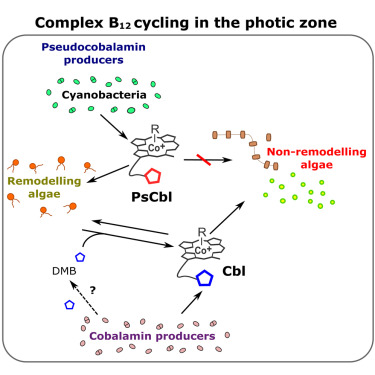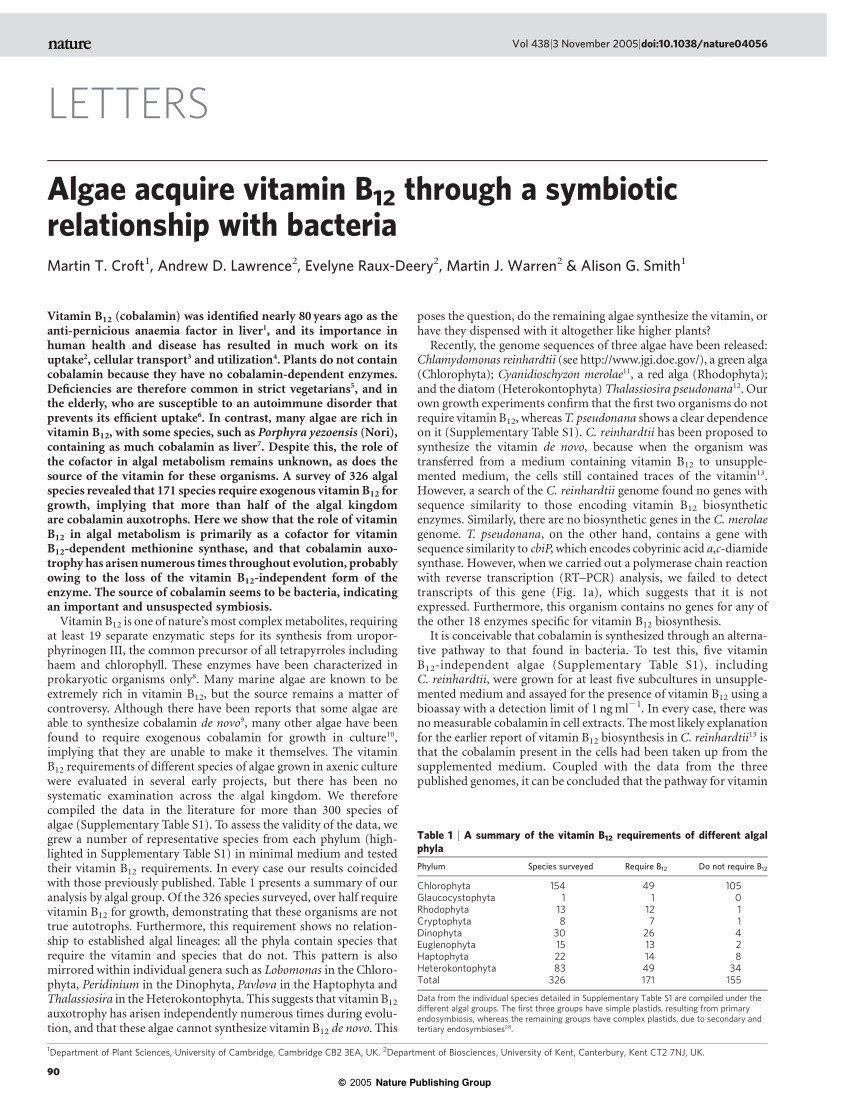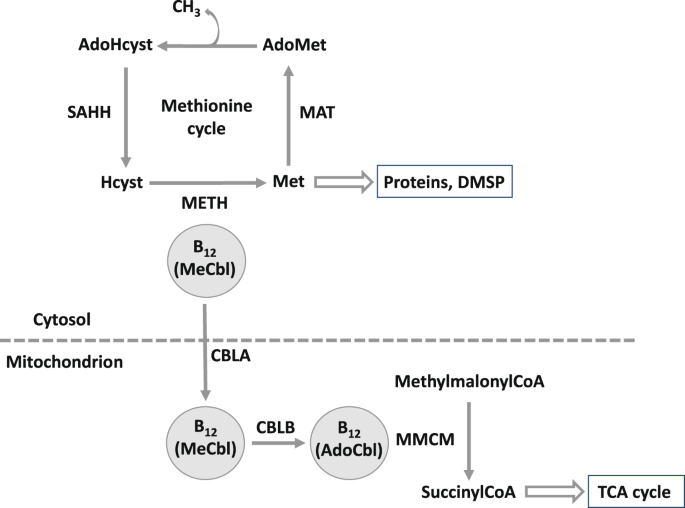- Joined
- Aug 23, 2018
- Messages
- 59
- Reaction score
- 35
I have read many speculations regarding the cause of cyano, but have never found one that has a clear and legitimately supported explanation.
Due to a growing problem of my chaeto, I began to look for the cause, finding that my UV was destroying vitamin B12 among others and my chaeto that grew wonderfully, began to die and the cyano appeared in some places in the aquarium, especially in the algae reactor.
In my readings I found that B12 is a very important vitamin for the growth of bacteria and algae and that it can become a limiting factor in favor of those with the ability to synthesize it, such as Cyano and a small group of bacteria. microbes and algae.
I have always thought that cyano, dinos, diatoms are caused by some biological or chemical imbalance in the aquarium! some things (vitamins, elements, nutrients) are missing.
B12 may be one of them!
Points of Discussion:
- Cyano in a reef tank may be due to a B12 deficiency or what other unbalances?
- How necessary is vitamin B12 for the healthy growth of bacteria and algae in a marine aquarium? Should it be supplemented?
- Knowing now that UV destroys vitamin B12, should it be used in a marine aquarium?
References:

 www.sciencedirect.com
www.sciencedirect.com
"Representatives of all major algal lineages require B12, yet its biosynthesis is limited to a subset of prokaryotes. As such, the flux of B12 between microbes is integral to the growth of auxotrophic species. Our results imply heterotrophic bacteria are likely to be a more important source of B12 for eukaryotic algae than cyanobacteria. An increasing body of evidence provided by this study and others [33, 34, 43, 44] suggests the relationship between requirers and providers has become blurred by the existence of scavengers and remodelers. That different B12 forms are not functionally equivalent between organisms means that biochemical transformations between vitamer classes are essential for this micronutrient to reach different members of the community. This complicates our current view of B12 cycling in aquatic environments (Figure 7). Whether cyanobacteria synthesize a currency of B12 that is inaccessible to competing eukaryotic microbes as a strategy to exclude competitors remains unknown. Nevertheless, the observation that certain algae possess a counter-mechanism to convert pseudocobalamin to a bioavailable form suggests the selective pressure to devise and refine strategies of B12 acquisition/utilization in order to enhance accessibility to this limiting micronutrient is strong. In any case, the importance of B12 and its derivatives in structuring microbial communities in aquatic ecosystems may have been previously underestimated."

 www.ncbi.nlm.nih.gov
www.ncbi.nlm.nih.gov
"The concentration of vitamin B12 in seawater is thought to vary between 0 and 3 ng/liter (9), and while higher levels have been reported in some freshwaters (12, 34), these levels are generally too low to support algal growth. Several studies have shown that different vitamin B12-dependent algae require at least 10 ng/liter cobalamin in order to grow (50). Similarly, the concentrations of both thiamine and biotin in the natural environment are below that normally required in culture, with thiamine levels typically varying between 8 and 15 ng/liter at different points in the Pacific Ocean and biotin varying between 1 and 4 ng/liter in the same regions (9). In the case of thiamine, the stability of the cofactor at the alkaline pH of seawater has been shown to be dependent on the temperature of the water, declining sharply between 10°C and 30°C (26)."

 www.researchgate.net
www.researchgate.net
"A survey of 326 algal species revealed that 171 species require exogenous vitamin B12 for growth, implying that more than half of the algal kingdom are cobalamin auxotrophs. Here we show that the role of vitamin B12 in algal metabolism is primarily as a cofactor for vitamin B12-dependent methionine synthase, and that cobalamin auxotrophy has arisen numerous times throughout evolution, probably owing to the loss of the vitamin B12-independent form of the enzyme. The source of cobalamin seems to be bacteria, indicating an important and unsuspected symbiosis.A survey of 326 algal species revealed that 171 species require exogenous vitamin B12 for growth, implying that more than half of the algal kingdom are cobalamin auxotrophs. Here we show that the role of vitamin B12 in algal metabolism is primarily as a cofactor for vitamin B12-dependent methionine synthase, and that cobalamin auxotrophy has arisen numerous times throughout evolution, probably owing to the loss of the vitamin B12-independent form of the enzyme. The source of cobalamin seems to be bacteria, indicating an important and unsuspected symbiosis."

 www.nature.com
www.nature.com
"Previous studies based on culture assays showed that on the 22 haptophytes species tested, 8 were able to grow without B12 addition and were considered as B12-independent"
Due to a growing problem of my chaeto, I began to look for the cause, finding that my UV was destroying vitamin B12 among others and my chaeto that grew wonderfully, began to die and the cyano appeared in some places in the aquarium, especially in the algae reactor.
In my readings I found that B12 is a very important vitamin for the growth of bacteria and algae and that it can become a limiting factor in favor of those with the ability to synthesize it, such as Cyano and a small group of bacteria. microbes and algae.
I have always thought that cyano, dinos, diatoms are caused by some biological or chemical imbalance in the aquarium! some things (vitamins, elements, nutrients) are missing.
B12 may be one of them!
Points of Discussion:
- Cyano in a reef tank may be due to a B12 deficiency or what other unbalances?
- How necessary is vitamin B12 for the healthy growth of bacteria and algae in a marine aquarium? Should it be supplemented?
- Knowing now that UV destroys vitamin B12, should it be used in a marine aquarium?
References:

Cyanobacteria and Eukaryotic Algae Use Different Chemical Variants of Vitamin B12
Eukaryotic microalgae and prokaryotic cyanobacteria are the major components of the phytoplankton. Determining factors that govern growth of these pri…
"Representatives of all major algal lineages require B12, yet its biosynthesis is limited to a subset of prokaryotes. As such, the flux of B12 between microbes is integral to the growth of auxotrophic species. Our results imply heterotrophic bacteria are likely to be a more important source of B12 for eukaryotic algae than cyanobacteria. An increasing body of evidence provided by this study and others [33, 34, 43, 44] suggests the relationship between requirers and providers has become blurred by the existence of scavengers and remodelers. That different B12 forms are not functionally equivalent between organisms means that biochemical transformations between vitamer classes are essential for this micronutrient to reach different members of the community. This complicates our current view of B12 cycling in aquatic environments (Figure 7). Whether cyanobacteria synthesize a currency of B12 that is inaccessible to competing eukaryotic microbes as a strategy to exclude competitors remains unknown. Nevertheless, the observation that certain algae possess a counter-mechanism to convert pseudocobalamin to a bioavailable form suggests the selective pressure to devise and refine strategies of B12 acquisition/utilization in order to enhance accessibility to this limiting micronutrient is strong. In any case, the importance of B12 and its derivatives in structuring microbial communities in aquatic ecosystems may have been previously underestimated."

Algae Need Their Vitamins
"The concentration of vitamin B12 in seawater is thought to vary between 0 and 3 ng/liter (9), and while higher levels have been reported in some freshwaters (12, 34), these levels are generally too low to support algal growth. Several studies have shown that different vitamin B12-dependent algae require at least 10 ng/liter cobalamin in order to grow (50). Similarly, the concentrations of both thiamine and biotin in the natural environment are below that normally required in culture, with thiamine levels typically varying between 8 and 15 ng/liter at different points in the Pacific Ocean and biotin varying between 1 and 4 ng/liter in the same regions (9). In the case of thiamine, the stability of the cofactor at the alkaline pH of seawater has been shown to be dependent on the temperature of the water, declining sharply between 10°C and 30°C (26)."

(PDF) Algae acquire Vitamin B12 through a symbiotic relationship with bacteria
PDF | Vitamin B12 (cobalamin) was identified nearly 80 years ago as the anti-pernicious anaemia factor in liver, and its importance in human health and... | Find, read and cite all the research you need on ResearchGate
"A survey of 326 algal species revealed that 171 species require exogenous vitamin B12 for growth, implying that more than half of the algal kingdom are cobalamin auxotrophs. Here we show that the role of vitamin B12 in algal metabolism is primarily as a cofactor for vitamin B12-dependent methionine synthase, and that cobalamin auxotrophy has arisen numerous times throughout evolution, probably owing to the loss of the vitamin B12-independent form of the enzyme. The source of cobalamin seems to be bacteria, indicating an important and unsuspected symbiosis.A survey of 326 algal species revealed that 171 species require exogenous vitamin B12 for growth, implying that more than half of the algal kingdom are cobalamin auxotrophs. Here we show that the role of vitamin B12 in algal metabolism is primarily as a cofactor for vitamin B12-dependent methionine synthase, and that cobalamin auxotrophy has arisen numerous times throughout evolution, probably owing to the loss of the vitamin B12-independent form of the enzyme. The source of cobalamin seems to be bacteria, indicating an important and unsuspected symbiosis."

How haptophytes microalgae mitigate vitamin B12 limitation - Scientific Reports
Vitamin B12 (cobalamin) can control phytoplankton development and community composition, with around half of microalgal species requiring this vitamin for growth. B12 dependency is determined by the absence of cobalamin-independent methionine synthase and is unrelated across lineages. Despite...
"Previous studies based on culture assays showed that on the 22 haptophytes species tested, 8 were able to grow without B12 addition and were considered as B12-independent"
Last edited:













